Decline in demand will force newsprint producers to examine cost-saving options, such as calcium carbonate fillers, that still allow mills to maintain good sheet quality
|
 |
Newsprint Mill Cost Pressures Drive Reassessment of Filler Alternatives
|
|
|
By TONY BLIXT
|
Changing reading habits and increasing competition from electronic media are expected to have a negative long-term impact on the consumption of standard newsprint in Western Europe and North America (Figure 1). This means that the cost pressures in this sector will continue to increase, and the difficulties for smaller high-cost newsprint machines to stay profitable will remain. To remain in business, mills equipped with such machines will have to find new product niches better suited for the cost structure of their operation.
The requirement for higher cost efficiency in the standard newsprint segment also manifests itself by the movement toward lower basis weights and increasing use of recycled fiber. In Europe, for instance, both UPM-Kymmene and Stora Enso have chosen to expand their newsprint capacity in the recycled fiber-rich region of Central Europe, while smaller newsprint machines in their organizations are either closed down or converted to value-added groundwood production.
 |
| FIGURE 1: Changing reading habits and media competition are expected to cause newsprint capacity to continue declining. (Source: Temanex, Inc.) |
 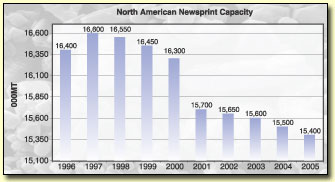  |
|
At the same time as cost pressures increase, so do demands for improved paper quality. The increasing practice of four-color printing, for instance, requires higher standards for both optical properties and for the ability of the paper to absorb high amounts of printing ink. To create paper better suited to meet these demands, newsprint producers add minerals that can create micro-pores in the sheet. The traditional materials for this purpose have been high scattering fillers such as calcined clay and precipitated silica. As in other paper grades, however, calcium carbonate is becoming an increasingly important pigment solution.
THE “ALKALINE REVOLUTION.” During the free-sheet “alkaline revolution” of the 1980s, recycled newsprint producers saw more and more calcium carbonate entering their system via the fiber source. To deal with the resulting alkalinity, manufacturers converted their papermaking processes from acid to neutral. This opened the possibility for mills to take advantage of all minerals present in the recycled pulp, as well as to add “fresh” calcium carbonate to the system. As the quality benefits became apparent, virgin fiber-based newsprint producers also started to show interest in calcium carbonate.
Newsprint fillers can be divided into filler from recycled fiber, specialty fillers, kaolin fillers, and calcium carbonate fillers. The three calcium carbonate fillers for newsprint are chalk, ground calcium carbonate (GCC), and precipitated calcium carbonate (PCC). All of these fillers are discussed briefly below.
Fillers from recycled fiber. The nature of the filler contained in recycled fiber depends on the origin of the wastepaper. Old newspapers, for instance, contain calcined clay, precipitated silica, or calcium carbonate. Old magazines usually contain large amounts of kaolin, calcium carbonate, and sometimes calcined clay. Sorted office paper and sorted white ledger usually contain large amounts of calcium carbonate.
Specialty fillers. Pigments in the specialty filler group include calcined clay, precipitated silica, polymer-based pigments, and titanium dioxide. Due to their high costs, these fillers must work effectively at very low addition levels (0.5 to 1.5%). The brightness of specialty fillers varies from ISO 85 for low-grade calcined clays up to ISO 97 for precipitated silica and titanium dioxide. A common application for specialty fillers is directory or other lightweight newsprint grades where an extra “kick” of brightness, opacity, and/or print-through reduction is often needed.
Kaolin. Kaolin (Figure 2) is sometimes used as filler in newsprint. Depending on the grade, the material can be less expensive than fiber and also can contribute positively to the print properties. The well-known drawbacks of kaolin, however, include limited optical performance, especially relative to brightness and opacity. Recycled paper with high amounts of kaolin sometimes has a tendency to close the sheet to a point where set-off can become a problem.
Chalk. The brightness (up to ISO 89) of chalk (Figure 2) is lower than GCC and PCC (up to ISO 97). Its softness, steep particle size distribution, low surface area, and excellent retention properties, however, make it a very effective newsprint filler in areas where the material can be obtained at a reasonable cost.
GCC. GCC (Figure 2) is by far the most commonly used carbonate filler in the European and Asian newsprint industries. GCC can be supplied at various particle size distributions and surface charges to satisfy specific customer requirements. GCC also imparts excellent optical and print properties without excessively increasing the porosity of the sheet. Modern grinding techniques have largely eliminated abrasion issues relating to GCC.
PCC. PCC (Figure 2) has recently made inroads into newsprint mills in the western part of the U.S. and Canada. PCC is usually applied in a scalenohedral crystal form. Scalenohedral PCC provides excellent optical and print properties, but does tend to open the sheet more than GCC and chalk.
 |
| FIGURE 2: (Clockwise from top left) Scanning electron micrographs of kaolin, chalk, ground calcium carbonate, and precipitated calcium carbonate |
 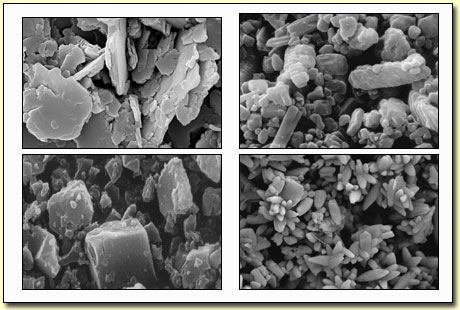  |
|
CALCIUM CARBONATE USE: WHO AND WHY? So far, calcium carbonate has been used mostly by “standard” newsprint producers interested in switching to “high-bright” grades or by recycled newsprint producers wanting to improve the print properties and/or to minimize the filler level fluctuations caused by uneven recycled paper quality.
The excellent optical properties of calcium carbonate can also be advantageous to mills that are under no specific pressure to improve the sheet quality. By adding 2 to 4% calcium carbonate, it is often possible to significantly reduce the amount of bleaching chemicals while maintaining the brightness specification. Taking advantage of filler brightness in this way not only saves cost but also results in a sheet with higher opacity.
Other cost saving opportunities with calcium carbonate include the replacement of expensive specialty fillers, fiber replacement, and better drainage and drying on the paper machine. In dryer-limited systems, the latter could result in increased paper machine productivity. Table 1 shows an example from a Northern European mill where an acid system without filler was converted to neutral conditions and calcium carbonate.
| TABLE 1: Calcium carbonate’s effect on TMP-based newsprint |
| Property |
Acid Mode (no filler) |
Nuetral Mode (8% chalk) |
| Bleach Type |
Hydrosulfphite |
No bleach |
| Steam Demand |
Reference |
-15% |
| Mach. Speed |
Reference |
+5% |
| Brightness |
58 |
59 |
| Opacity |
92 |
95 |
| Show through |
12 |
9 |
| Roughness |
Reference |
Unchanged |
| Tensile Strength |
Reference |
-10% |
| Porosity |
Reference |
+10% |
| Print Quality |
Reference |
Improved |
|
The maximum calcium carbonate level in the paper depends on both the manufacturing process and the type of newsprint being produced. Typically, recycled fiber users gain at least 5% mineral “for free” from the pulp, limiting the amount of fresh filler that can be added to the system. Virgin fiber-based systems often allow addition of more fresh filler, but the exact amount depends on basis weight, fiber type, machine equipment, and wet end chemistry.
Typical filler addition levels are:
• Standard newsprint (virgin fiber base): 5 to 10%
• Standard newsprint (recycled fiber base): 1 to 5%
• High-bright newsprint: 5 to 18%
• Directory papers: 1 to 5%
Limiting factors to the amount of filler include strength deterioration, dusting, and porosity. Refining procedures, calcium carbonate type, and wet end chemistry can be used to control the severity of these factors. It is also quite common to see a system increase its filler levels over time as these control parameters are optimized.
CONVERSION TO NEUTRAL PAPERMAKING. All calcium carbonate products, including the varieties marketed as able to “tolerate” low pH, are chemically unstable under acid conditions. To successfully apply chalk, GCC, or PCC, it is always necessary to convert the papermaking process from acid to neutral. Compared with free-sheet papers, mechanical furnishes used in newsprint present additional challenges that need to be brought under control. These may include:
• Alkaline brightness reversion
• Pitch and stickie reactivity
• High “anionic trash” levels
• Changing microbiological conditions.
The severity of these variables can vary greatly depending on machine type, system closure, white water management, wood species, pulping process, and wet end chemistry.
Figure 3 shows how critical properties, such as pH-induced brightness reversion and anionic trash concentration, can be improved with the right combination of mechanical and chemical measures.
 |
| FIGURE 3: Effect of chelant on brightness in a system with high levels of transition metals |
 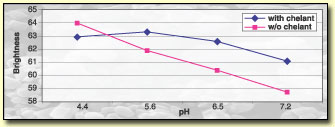  |
|
Because systems can vary significantly, individual conversion strategies must be developed for each case. This requires a thorough chemical and mechanical system analysis, including all potential “trouble” areas in both the paper and the pulp mill.
Calcium carbonate suppliers may have different capabilities in providing conversion services and expertise. A few have gained solid experience from many newsprint conversions and should be well positioned to provide a reliable system diagnosis and a detailed wet end conversion strategy.
CARBONATE SELECTION CRITERIA. As mentioned previously GCC, PCC and chalk are used successfully in newsprint applications all over the world. Figures 5-7 show that all three provide excellent optical and print quality enhancing properties.
 |
| FIGURES 5-7: Comparison of calcium carbonate versus various sheet characteristics |
 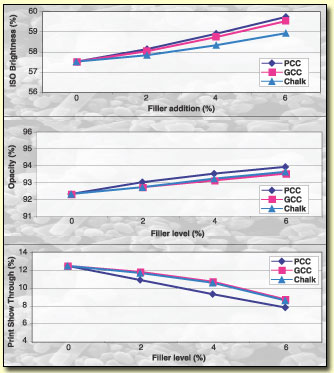  |
|
Since all three carbonate types potentially could “do the job,” the right choice for a particular system doesn’t always have to be determined by the relatively minor differences in optical performance. Papermakers also need to carefully determine the total cost of the application including runnability and mechanical properties.
Relatively speaking, with the low mineral demand of newsprint mills, onsite PCC is typically not a cost-effective solution. Because of this, newsprint fillers will usually be supplied to the mill in slurry form, via rail or truck, from an externally located mineral plant. The delivered cost of the product will be greatly affected by the distance between the paper mill and the pigment plant, and the solid concentration of the product must be taken into consideration.
The slurry solids concentration deserves some extra attention. It is obvious that the higher the solids the lower the delivered cost of the product. High solids, however, usually mean a higher amount of anionic dispersant and therefore a higher anionic charge. Although this can be overcome by addition of more cationic polymers on the paper machine, the optimum balance between slurry concentration and dispersant level needs to be determined when comparing the overall performance of different calcium carbonate options (Figure 8).
To guarantee a successful outcome, the conversion of a newsprint mill must be preceded by a thorough system analysis and optimization of machine configuration and wet end chemistry. It is particularly important that the amount of recirculated “troublesome” substances, such as dissolved calcium, anionic trash, and organic colloidal matter, are kept at a minimum.
GCC, chalk and PCC, can be used to satisfy the demand for brightness, opacity, and print properties in newsprint grades. To determine the most suitable product option for a given situation, it is important to look at all aspects of the application, including the technical performance, the mechanical performance, and the delivered cost.
 |
| FIGURE 8: Cationic demand of some calcium carbonate fillers |
 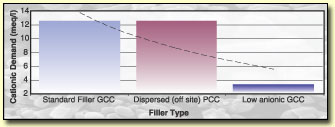  |
|
Calcium carbonate suppliers are constantly working to improve the efficiency of their products. Recent developments include products with steeper particle size distribution and new dispersing agents allowing very high solid slurries at low anionic charge.
New, modified calcium carbonates with very high surface areas are also under development. These structures could prove to be economical alternatives to specialty fillers, such as precipitated silica, in the low basis weight segment of the market. It is likely that more information will be available on these developments in the future as efforts are made to improve the productivity and quality of newsprint grades.
TONY BLIXT is market manager, uncoated groundwood papers, Omya AG, Oftringen, Switzerland.
|